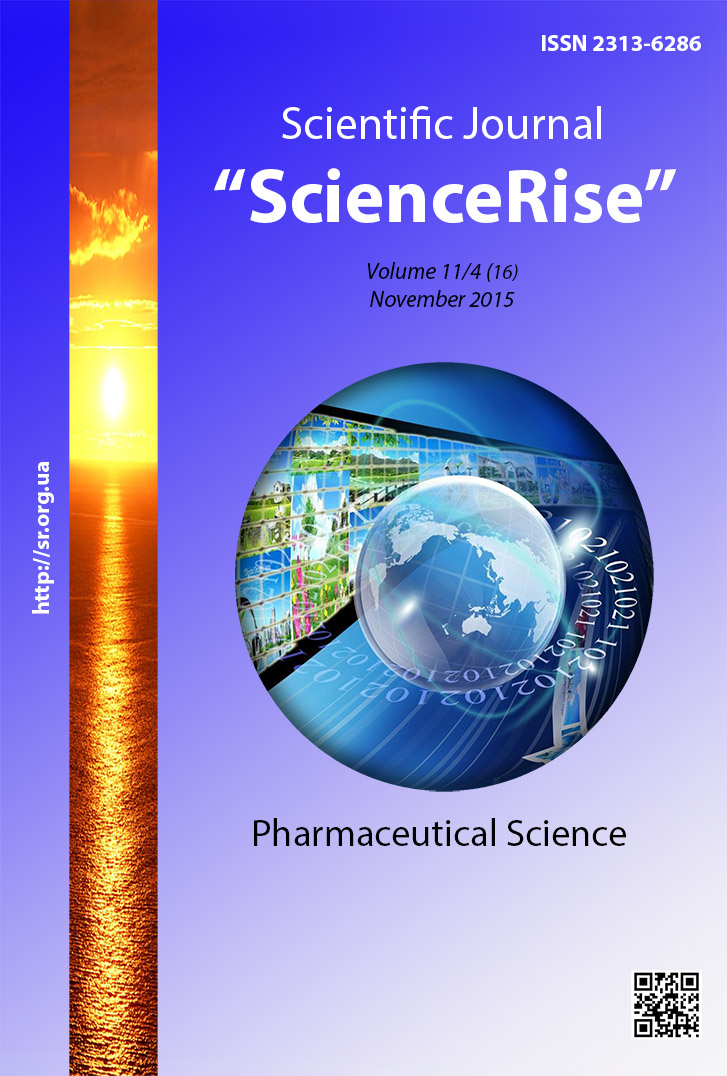Analysis and expansion ways of the extemporaneous preparations assortment in the republic of Tajikistan
DOI:
https://doi.org/10.15587/2313-8416.2015.54991Keywords:
extemporaneous preparations, analysis of the recipe, compounding pharmacy, medicinal formsAbstract
For last twenty years in Post-Soviet states a gradual reduction in the amount of prepared extemporaneous formulations has been observed, many economic entities are reluctant to engage in this type of activity due to a number of regulatory and economic reasons. At the same time in Republic of Tajikistan there is a need to provide, specific for individual patients, medications readily not available in the market.
Aim: The purpose of this paper is to analyze prescriptions in compounding pharmacies of the Republic of Tajikistan and search for ways to expand the range of extemporaneous preparations.
Methods: The generally accepted analysis of literature sources, range of extemporaneous preparations, methods of synthesis and compilation were employed.
Results: The analysis of the compounding preparation formulations was carried out in Tajikistan based on data obtained from the State Inspectorate of the Republic of Tajikistan for 2012. The assortment of extemporaneous preparations is made up of eye and ear drops, nose drops, powders, ointments, solutions for outdoor and indoor use, and drugs for parenteral use.
Conclusions: Results of the analysis of pharmacy compounded preparations in Tajikistan confirm the need to revise and update formulations; develop new formulations and introduce modern and more effective active pharmaceutical ingredients. There are prospects for development of extemporaneous prescriptions in palliative care, hormone replacement therapy, medical assistance to athletes, for use in pediatry, geriatry, veterinary, dentistry, dermatology
References
Vlasenko, I. O. (2008). Ekstemporal'ne vygotovlennja – vizytna kartka klasychnoi' apteky. Farmacevt-praktyk, 5, 60–62.
Egorova, S. N., Nevolina, E. V. (2013). Aptechnoe izgotovlenie lekarstvennyh form: problemy, trebujushhie pravovogo reshenija. Vestnik Roszdravnadzora, 6, 36–38.
Sjatynja, M. L., Popovych, V. P., Glushhenko O. M. et. al. (2011). Indyvidual'ne vygotovlennja likiv v aptekah. Farmacevtychnyj chasopys, 4, 90–95.
Carvalho, M., Tuleu, C., Taylor, K. (2008). Current Compounding Practices in Europe. International Journal of Pharmaceutical Compounding, 2, 94-99.
Vail, J., Naddeo, A. M., Kinget, R. et. al. (2008). Compounding Around the World. International Journal of Pharmaceutical Compounding, 2, 102–115.
Kolesnik, M. (2007). Jekstemporal'naja receptura: realii i perspektivy. Provizor, 19, 57–60.
Kolesnik, M. (2007). Jekstemporal'noe proizvodstvo: byt' ili ne byt'? Provizor, 3, 8–12.
Kosjachenko, K. L., Nemchenko, A. S. (2011). Analiz suchasnyh organizacijno-ekonomichnyh problem vygotovlennja likars'kyh zasobiv v umovah apteky. Upravlinnja, ekonomika ta zabezpechennja jakosti v farmacii', 2 (16), 34–39.
Krasnjuk, I. I., Sboev, G. A. (2006). Problemy garmonizacii aptechnoj praktiki s mezhdunarodnoj sistemoj farmacevticheskoj pomoshhi. Remedium, 8, 38–40.
Kryvov’jaz, O. V., Golod, A. S. (2011). "Personal'ni liky" jak racional'nyj shljah vidrodzhennja ekstemporal'noi' receptury v Ukrai'ni. Aktual'ni pytannja farmacevtychnoi' i medychnoi' nauky ta praktyky, 24 (2), 81–83.
Ponomareva, E. A., Tjurenkov, I. N. (2010). Realii aptechnogo izgotovlenija lekarstvennyh sredstv. Remedium, 11, 47–48.
PIC/S Guide to good practices for the preparation of medicinal products in healthcare establishments. PE 010-3, 1 October 2008. Available at: http://www.picscheme.org/
A guide for compounding practitioner USP 35 - NF 30 / The United States Pharmacopeial Convention (2012). Rockville, 317.
Jevtifjejeva, O. A. (2013). Analitychnyj ogljad systemy zabezpechennja jakosti ekstemporal'nyh likars'kyh zasobiv u rozvynutyh krai'nah svitu. Visnyk farmacii', 1, 9–18.
Sabirzhan, R. R. (2012). Aptechnoe izgotovlenie lekarstvennyh form dlja lechebno-profilakticheskih uchrezhdenij: izuchenie sovremennoj nomenklatury. Nauchnye vedomosti BelGU. Serija: Medicina. Farmacija, 10-2 (129), 31–35.
Tihonov, A. I. (Ed.) (1999). Spravochnik jekstemporal'noj receptury. Kyiv: MORION, 496.
Foppe vann Mil, Dzh. V., Dzh. Mak Elni, T. F. (2001). Obshhestvennaja farmacija v mire. Farmac. zhurn., 6, 27–32.
World Health Organization official website. Available at: http://www.who.int/en/
Schotik, D. (2001). Stability Issues for Compounding Extemporaneously Prepared Oral Formulations for Pediatric Patients. Int J Pharm Compd., 1, 9.
Zdoryk, O. A. (2013). Svitovyj dosvid vyznachennja terminu prydatnosti likars'kyh zasobiv aptechnogo vygotovlennja. Farmac. zhurn., 6, 42–47.
Downloads
Published
Issue
Section
License
Copyright (c) 2015 Абдуджаббор Халкуллоевич Валиев, Александр Анатольевич Здорик

This work is licensed under a Creative Commons Attribution 4.0 International License.
Our journal abides by the Creative Commons CC BY copyright rights and permissions for open access journals.
Authors, who are published in this journal, agree to the following conditions:
1. The authors reserve the right to authorship of the work and pass the first publication right of this work to the journal under the terms of a Creative Commons CC BY, which allows others to freely distribute the published research with the obligatory reference to the authors of the original work and the first publication of the work in this journal.
2. The authors have the right to conclude separate supplement agreements that relate to non-exclusive work distribution in the form in which it has been published by the journal (for example, to upload the work to the online storage of the journal or publish it as part of a monograph), provided that the reference to the first publication of the work in this journal is included.

